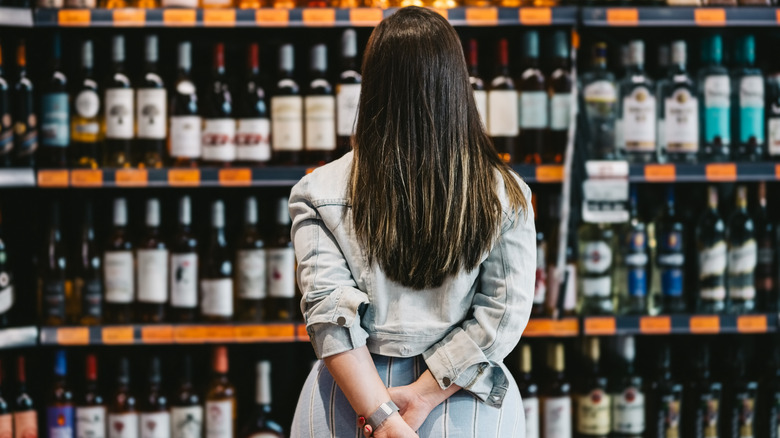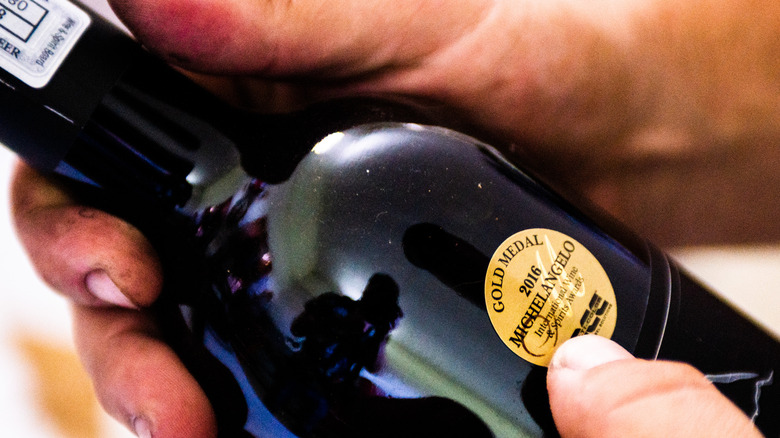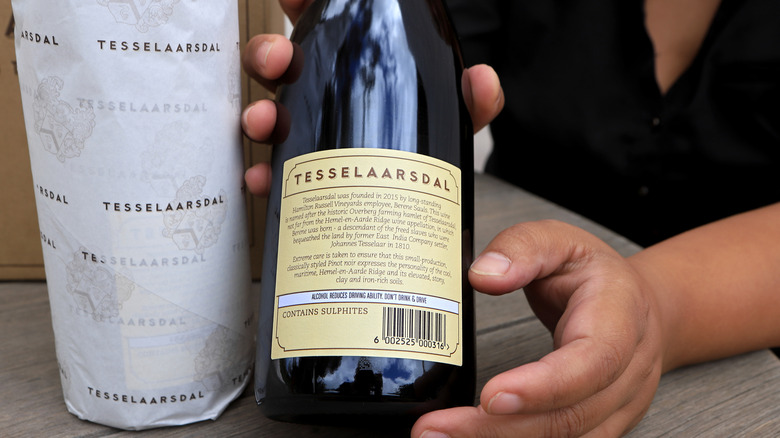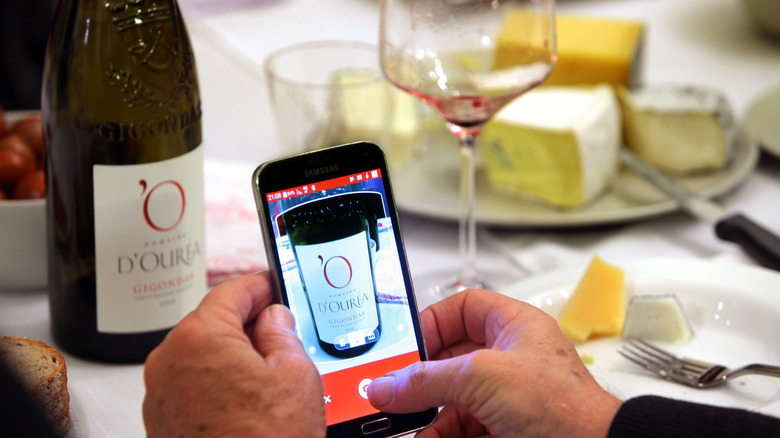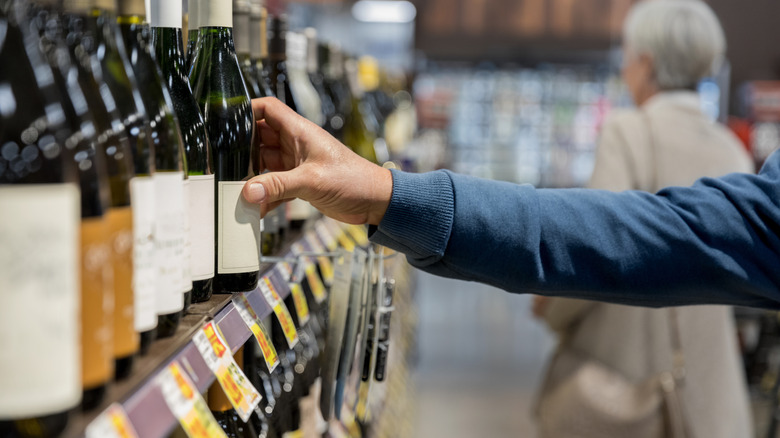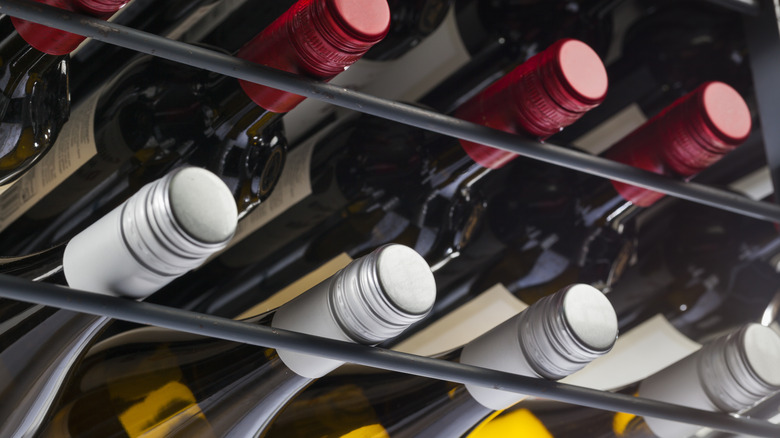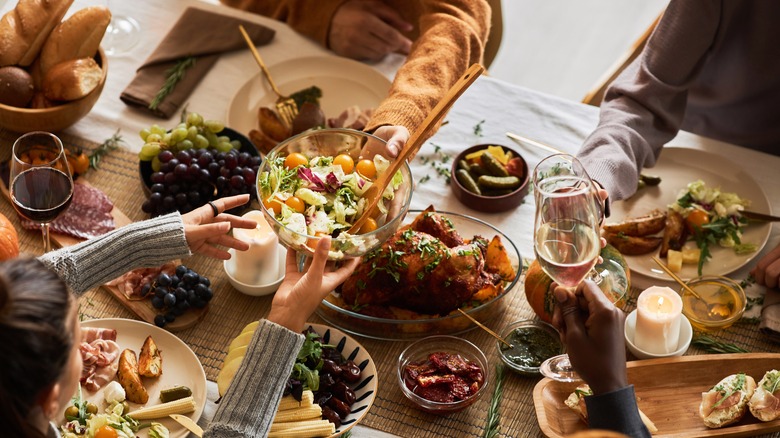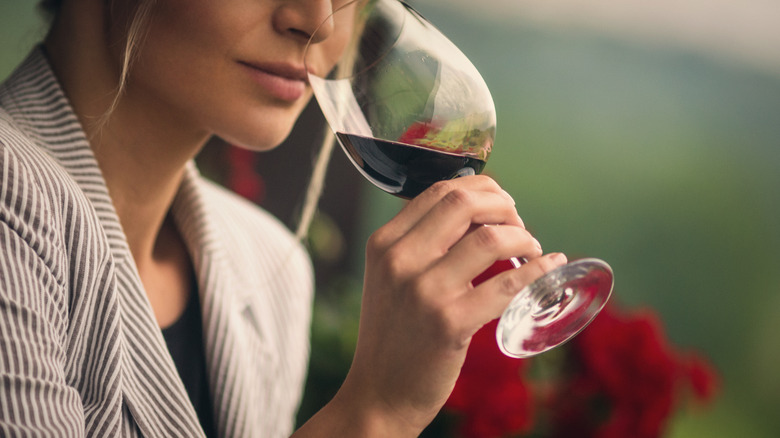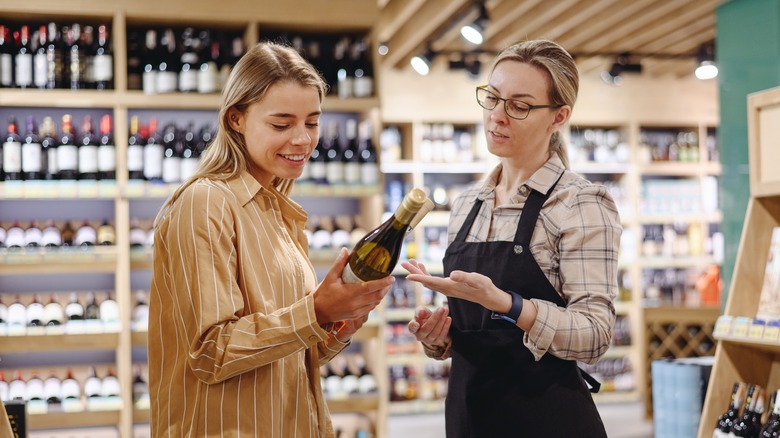Avoid These 12 Mistakes When Shopping For A Bottle Of Wine
Buying wine can evoke a range of feelings; maybe your motto "less is more" makes the average wine shop far too overwhelming, or perhaps you're always hung up on trying to pick the perfect wine for the occasion. Either way, it can be tough to walk into a store and find something you like without feeling a bit of buyer's remorse. You might think your chances of success are limited without being a trained sommelier, but that's far from the truth.
It isn't about knowing every last detail of the wine world, but about being able to assess a few basic factors that will guide you along the way. As a certified specialist in wine who has worked in several tasting rooms and wineries, I've certainly found myself overwhelmed with everything there is to know on the topic.
So, by honing in on these 12 mistakes people commonly make when shopping for wine and learning skills to avoid them, you'll be well on your way to success. Whether you're looking for a bottle to serve with dinner or a gift for a special occasion, you'll be set.
1. Letting the front label guide your decision
A lot of marketing goes on behind the scenes to make wine bottles desirable to consumers. When faced with a sea of options it's natural to gravitate toward wines with the most eye-catching labels, but don't expect the exterior to translate what's inside. Nic Rizzi, owner of Modal Wines in London, England, told The Independent, "It's sad to say but an incredible wine with a terrible label will typically be a slower mover" adding that, "customers buy with their eyes first and foremost." It's also apparent that social media is a key driver of this trend since flashier labels stick in consumers' heads as they scroll through endless images.
The old saying "Don't judge a book by its cover" is certainly relevant, especially when you consider budgets for winemaking can only be split in so many ways. Designing a photogenic label might pull in some consumers, but is the same amount of effort going into wine production and vineyard care? Meanwhile, natural wines often prioritize splashy labels, making up for lesser-known grapes and regions with recognizable images plastered across the front of a bottle.
If you're posting a photo or wanting something aesthetically pleasing to look at for the duration of your meal, it's understandable to lean toward fancy-labeled bottles. Nevertheless, to avoid falling prey to carefully strategized marketing ploys, consider looking beyond the catchy image and reading up on the producer and wine.
2. Focusing solely on the point system
Gold stars and high scores might seem like an obvious endorsement for a bottle, but it's worth considering how the wine received these accolades. Wine critics and publications face multiple influences, and although objectivity is the aim, it is not a guarantee. Opinions stand out, and it's natural for someone whose palate skews toward bold tannic red wines to be predisposed to rate those higher.
There's rarely consensus across the board, so at best you're learning about a specific critic's taste when you look at a score. Furthermore, multiple rating systems like the 100-point scale aren't used across all publications, making it hard to conclude anything with certainty. If you do find the numerical system to be a useful way to make your selection, consider identifying a critic with whom you generally agree.
High wine scores aren't a sign that every consumer will love a bottle; instead, they indicate how typical a certain wine is to a particular region and grape variety. Not to mention, the majority of wines produced aren't even rated, as the process can be time-consuming and simply not worth it for smaller wineries to engage in. Ultimately, the numerical value fits certain criteria, but the assessment that led to that result isn't as objective as it appears on the label.
3. Being swayed by advertising speak
A great marketing pitch can make or break a sale, and the business of wine is no different. A lot of thought is given to creating the perfect blurb on the back of the label to incite consumers to fork over their hard-earned cash. While some brands stick to technical information about the vinification process, others opt for a story-telling approach. The same wine might be bottled with two different labels to reach a wider consumer market.
A quick look at wine marketing tactics shows that producers are encouraged to tell a story on their labels to humanize the brand. By selecting details that stand out to consumers, a product becomes relatable and easy to recognize, making it more likely that people reach for it the next time they're faced with a wall of unfamiliar bottles.
However, while it's certainly more entertaining to read a label with an interesting backstory, it doesn't always match up with the objective quality of the product. So, it's worth questioning how much time and energy went into the winemaking step when the company is doing everything possible to market its wine with tales that pull at your heartstrings
4. Depending entirely on wine apps
Wine apps have become increasingly ubiquitous in recent years, and chances are their popularity isn't wavering any time soon. While they can track bottles you've consumed or provide price estimates, most depend on input from users who are likely not professional wine experts i.e. consumer reviews. That means when they rate a wine, it contributes to the overall rating you see. Since the reviews come from people with subjective opinions, the result will be an average rating of the bottle. You might as well ask everyone in the shop their opinion on red wines from France and use that to decide for or against buying a bottle in that category — not exactly foolproof.
There's still room for wine apps in your tasting journey. Common tasting notes are included for most wines, providing an idea of what to expect — especially if the back label waxes poetic about the morning dew in the vineyard instead of describing the liquid. Furthermore, many apps recommend bottles based on those you've chosen previously, assisting with narrowing down the selection. Looking for something to pair with a particular food? There's a function on most apps for that. Additionally, if you live in a big city, you may be able to find stores selling specific bottles. Just take the reviews with a grain of salt; after all, who's to say you share the same tastes as whoever wrote them?
5. Failing to take notes about past purchases
Whereas you might not want to rely on wine apps to make all your purchasing decisions, many offer an efficient format for tracking what you've been drinking. If you're experimenting with a range of wines, you'll quickly forget your opinion on the previous bottles as you add more to your repertoire. A paper and pen will do the trick too, but wine apps make it simple to note your relevant previous purchase information. Plus, you can snap a picture of the bottle, which can help retrieve a memory of the drinking experience.
If you're all about reducing screen time, basic elements to write in your notes include region, style, variety, tasting notes, and food pairings. Whatever the medium, the goal is to understand what you've enjoyed in the past, so you have some guidance to assist your future purchases. Creating a personal rating system can be helpful too, so you can contextualize the various bottles you try.
As you take notes, look out for regions, aromas, or other features that regularly spring up in your list of favorite wines. You might realize that you gravitate toward citrusy white wines with mineral notes, or prefer your red wines to be oak-aged with a high ABV. These hints can serve as cues to share with a wine clerk when looking to branch out with your next purchase.
6. Using price as a guideline for quality
It's important to note that wine price doesn't reflect its quality, as a wide range of factors from vineyard costs and location to bottling and advertising all add up to the price tag. This is certainly reassuring since there are way too many opportunities to splurge in a wine shop, and it's easy to be swayed by a bottle marketed to look like a higher-end product.
With such a large selection on the market, there are ample choices in the $15 to $20 price point considered premium wine, offering a solid example of a wine region at a good value. Expanding this category up to $25 makes up the segment of the market with the greatest volume of sales in 2022, according to Wine-Searcher. Below this price, you'll find less reliable or interesting offerings, though the $10 to $15 range is still considered popular premium wines.
Sure, if you're looking to stock your wine cellar with particularly noteworthy bottles, or want to splash out and buy wine from a prestigious region or producer, you'll probably have to shell out more. Yet, don't necessarily expect the taste to correlate with the higher price. Of course, your brain will probably play tricks on you and make you think it tastes better if you know it's more expensive, as evidenced by a 2017 study published in Nature.
7. Buying table wine for aging
It's easy to get sucked into the idea that older wine is always better. After all, it tends to get a lot of buzz and garner hefty prices — especially if you've looked into the auction scene. Nevertheless, there are specific criteria that determine whether wine is worthy of aging, and spoiler alert, the majority of bottles on the market don't fit the bill. By most accounts, up to 99% of wines should be consumed within a year or two.
That's because characteristics such as high acidity, tannin, alcohol, balance, residual sugar, and oak aging all influence whether the liquid can stand the test of time. Furthermore, even if your wine has these features, you need to be storing it in optimal conditions to ensure it ages gracefully. Thankfully, many producers only release their wines for sale after they have aged for a few years, so customers can purchase and drink them at their peak.
8. Thinking that vintage is always important
With all the talk about vintage, you'd be forgiven for thinking it is of utmost importance for all bottles. Truthfully, it's most relevant in regions of the world where seasonal climates see significant variations from one year to the next. Regions in France, namely Burgundy, Bordeaux, and Champagne, experience significant shifts due to premature frost, hail, and other conditions that can damage vines. Other areas of the world, such as South America, Spain, and Australia, see less fluctuation.
Regardless of the effects of weather on a given harvest, winemakers can still adjust the result in the cellar to some extent. After all, they aim to make the best wine possible with the fruit they grow. Additionally, the outcomes of less successful vintages aren't uniform, nor do they necessarily mean the wine will be bad. It might offer a different style, like being fruitier due to plenty of sunlight and heat.
If you're planning on purchasing a high-end bottle from a trickier region, then sure, examine a vintage chart, which makes predictions of wine longevity based on the characteristics of a particular year. Don't expect the average wine store clerk to have memorized the optimal vintages for all regions. This type of information is specific and constantly evolving, so your best bet is to look it up if money is on the line.
9. Perceiving screw cap wines as lesser quality
If your eyes skip past the screw-top bottles on the shelf, seeking out finer quality cork seals, you're missing out on a good chunk of the wine market. Countries like Australia and New Zealand have long prioritized screw caps for their wines, going all in with the Screwcap Wine Seal Initiative since 2001. Over the years, many more regions and producers have followed suit, whether due to high cork cost, sustainability, or a desire for a more consistent closure.
The effect of screw caps on wine quality has been extensively studied, and the results have been highly positive. Studies show they offer consistent oxygen transfer into the bottle over time (via Robb Report). In turn, the wine oxidizes at a predictable rate, meaning that the factors that cause it to age are easier to assess. Guaranteeing longer-term freshness is a key quality of screw caps, ensuring that wine continues to taste vibrant over time.
Although corks have long been the go-to closure for wine bottles, they pose issues such as cork taint, unpredictable rates of oxidation, and variability over time. While they might call for a more ceremonial experience compared with a simple twist of the wrist, corks aren't as impressive as consumers have been led to believe. Don't let the closure make or break your decision to purchase a bottle.
10. Not considering the drinking occasion
Part of wine's appeal is the way it transforms to fit the experience. Pop open a cheap bottle of chilled wine at a sunny picnic and it might as well be the finest stuff you've ever drunk. Serve the same bottle at a dinner party with your in-laws and it might not be as appreciated. Ultimately, the occasion can influence your perception of a wine, whether it's due to the company, the atmosphere, or the food you're serving.
You don't have to be a pro to pair wine and food, but it helps to know what you're eating if you're choosing a bottle to go with dinner. Otherwise, you might fall prey to choosing a bottle that sounds great but completely overwhelms the food — say, a bold cabernet sauvignon with a delicate piece of white fish. Think about the protein, sauces, and the cuisine you're serving. For example, pick out a bottle from the same region and the odds that it pairs well will be greater than chance.
Meanwhile, avoid splurging on a bottle if the circumstances aren't fitting. For example, if your friend always pours wine into a pitcher to make sangria, it might not be the time to bring a special bottle. On the other hand, if you've been invited to dinner and know the host appreciates wine, consider choosing something that could evoke their curiosity. When in doubt, sparkling wine enhances any occasion.
11. Failing to explore beyond the usual
You might be a person of creature comforts, but when it comes to wine, you're doing yourself a disservice if you don't branch out into different bottles. Considering there are around 10,000 grape varieties, there's no excuse to stick to your favorite few. Of course, branching out can feel intimidating with such a large selection of options, so a systematic approach to your experimentation helps.
The next time you find yourself reaching for that bottle of chardonnay, stop and ask the wine clerk if they can recommend anything similar. Alternatively, do the research yourself; plenty of grapes overlap flavor profiles categorized as fruity, aromatic, herbal, savory, and so on. If you're taking notes about what you like, you'll be able to hone in on a style to explore. You might find that your love for pinot grigio extends to muscadet or vinho verde.
Meanwhile, if you're a true fan of syrah, how about tasting it from as many different regions as possible? On the flip side, do a deep dive into a particular region to discover everything it has to offer. Italian wine might seem like a basic category but it includes hundreds of grape varieties and over a dozen distinct wine regions.
12. Not speaking with wine clerks
If you're buying wine at Costco, you might not be able to rely on the expertise of every employee. However, if you're purchasing it at a wine or liquor shop, staff members are more likely to have some knowledge of the topic. In these cases, make a point to ask for advice if you're uncertain about what to buy.
With such a large selection available in stores, chances are you won't be able to discern the nuances of the collection at a glance. Store employees, on the other hand, have likely been informed about new bottles, different producers, and interesting options. They've probably tasted several of them too, and may have pairing recommendations.
That said, asking for and receiving assistance can be difficult if you have no parameters for your search. Consequently, consider a few elements to help the clerk guide you; price range, occasion, food pairing, and the general flavor profile you're looking for can all lead them in the right direction. Even better, if you can identify a few bottles or grape varieties you've enjoyed in the past, be sure to share that with the staff member so they can get a better idea of your taste.

